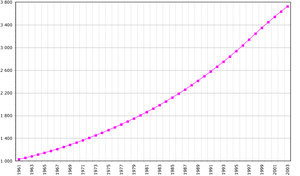Demographics of the Republic of the Congo
2007 Schools Wikipedia Selection. Related subjects: African Geography
The Republic of the Congo's sparse population is concentrated in the southwestern portion of the country, leaving the vast areas of tropical jungle in the north virtually uninhabited. Thus, Congo is one of the most urbanized countries in Africa, with 85% of its total population living in a few urban areas, namely in Brazzaville, Pointe-Noire, or one of the small cities or villages lining the 332-mile railway which connects the two cities. In rural areas, industrial and commercial activity has declined rapidly in recent years, leaving rural economies dependent on the government for support and subsistence. Before the 1997 war, about 15,000 Europeans and other non-Africans lived in Congo, most of whom were French. Presently, only about 9,500 remain.
Demographic data from the CIA World Factbook
Population
- 3,702,314
- Note: estimates for this country explicitly take into account the effects of excess mortality due to AIDS; this can result in lower life expectancy, higher infant mortality and death rates, lower population and growth rates, and changes in the distribution of population by age and sex than would otherwise be expected (July 2006 est.)
Age structure
- 0-14 years: 46.4% (male 864,407/female 853,728)
- 15-64 years: 50.7% (male 930,390/female 945,545)
- 65 years and over: 2.9% (male 44,430/female 63,814) (2006 est.)
- 15-64 years: 50.7% (male 930,390/female 945,545)
Population growth rate
- 2.6% (2006 est.)
Birth rate
- 42.57 births/1,000 population (2006 est.)
Death rate
- 12.93 deaths/1,000 population (2006 est.)
Net migration rate
- -3.62 migrant(s)/1,000 population (2006 est.)
Sex ratio
- At birth: 1.03 male(s)/female
- Under 15 years: 1.01 male(s)/female
- 15-64 years: 0.98 male(s)/female
- 65 years and over: 0.7 male(s)/female
- Total population: 0.99 male(s)/female (2006 est.)
- Under 15 years: 1.01 male(s)/female
Infant mortality rate
- Total: 85.29 deaths/1,000 live births
- Male: 91 deaths/1,000 live births
- Female: 79.41 deaths/1,000 live births (2006 est.)
- Male: 91 deaths/1,000 live births
Life expectancy at birth
- Total population: 52.8 years
- Male: 51.65 years
- Female: 53.98 years (2006 est.)
- Male: 51.65 years
Total fertility rate
- 6.07 children born/woman (2006 est.)
HIV/AIDS
- Adult prevalence rate: 4.9% (2003 est.)
- People living with HIV/AIDS: 90,000 (2003 est.)
- Deaths: 9,700 (2003 est.)
- People living with HIV/AIDS: 90,000 (2003 est.)
Major infectious diseases
- Degree of risk: very high
- Food or waterborne diseases: bacterial diarrhea, hepatitis A, and typhoid fever
- Vectorborne disease: malaria (2005)
- Food or waterborne diseases: bacterial diarrhea, hepatitis A, and typhoid fever
Nationality
- Noun: Congolese (singular and plural)
- Adjective: Congolese or Congo
Ethnic groups
- Kongo 48%, Sangha 20%, M'Bochi 12%, Teke 17%, Europeans and other 3%
Religions
- Christian 50%, animist 48%, Muslim 2%
Languages
- French (official language and the language of the elite), Lingala and Kituba (national languages and linguae francae among common people), many local languages and dialects (of which Kikongo is the most widespread)
The majority of the population is concentrated along the railroad between Pointe-Noire and Brazzaville in the south where Kituba (a creole language based on Kikongo) is the primary language. Lingala is influential in the sparsely inhabited northern half of the country.
Literacy
- Definition: age 15 and over can read and write
- Total population: 83.8%
- Male: 89.6%
- Female: 78.4% (2003 est.)
- Total population: 83.8%
Algeria • Angola • Benin • Botswana • Burkina Faso • Burundi • Cameroon • Cape Verde • Central African Republic • Chad • Comoros • Democratic Republic of the Congo • Republic of the Congo • Côte d'Ivoire (Ivory Coast) • Djibouti • Egypt • Equatorial Guinea • Eritrea • Ethiopia • Gabon • The Gambia • Ghana • Guinea • Guinea-Bissau • Kenya • Lesotho • Liberia • Libya • Madagascar • Malawi • Mali • Mauritania • Mauritius • Morocco • Mozambique • Namibia • Niger • Nigeria • Rwanda • São Tomé and Príncipe • Senegal • Seychelles • Sierra Leone • Somalia • South Africa • Sudan • Swaziland • Tanzania • Togo • Tunisia • Uganda • Western Sahara (Sahrawi Arab Democratic Republic) • Zambia • Zimbabwe
Dependencies and other territories
British Indian Ocean Territory • Canary Islands • Ceuta • Melilla • Madeira Islands • Mayotte • Réunion • St. Helena
This article contains material from the CIA World Factbook (2006 edition) which, as a US government publication, is in the public domain.
